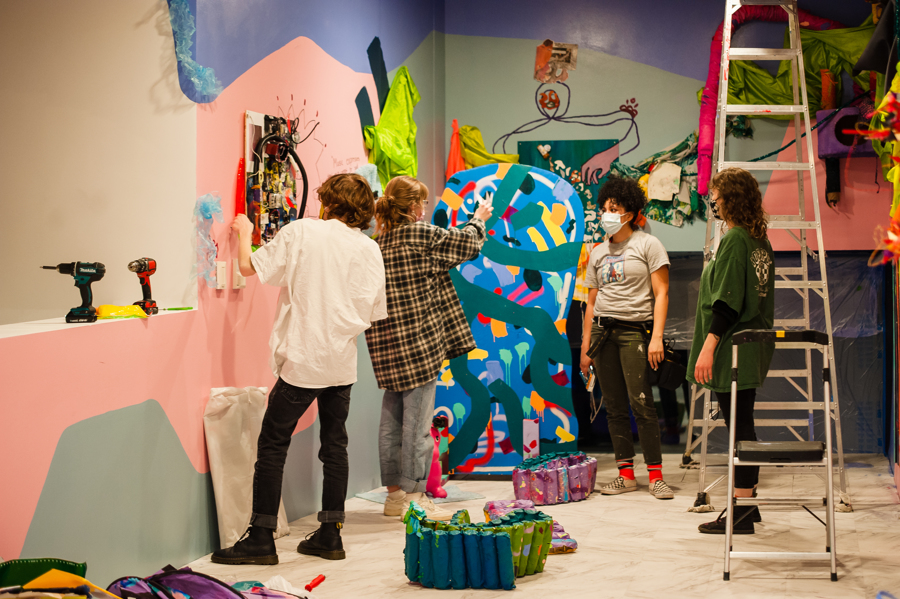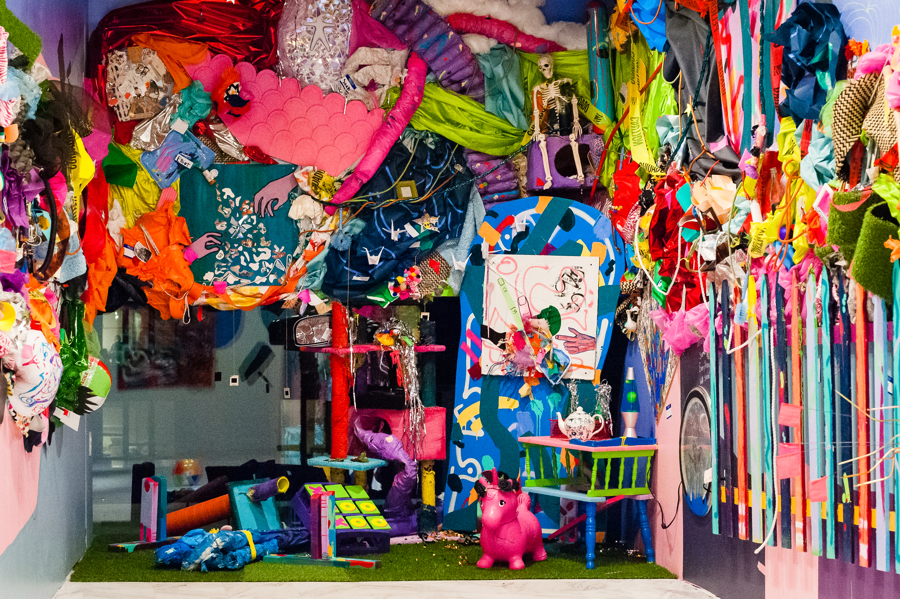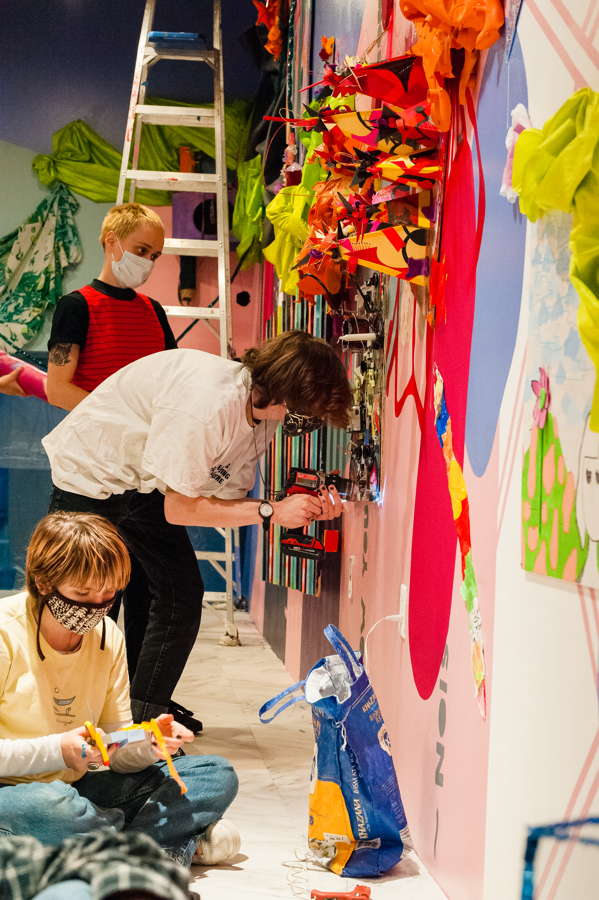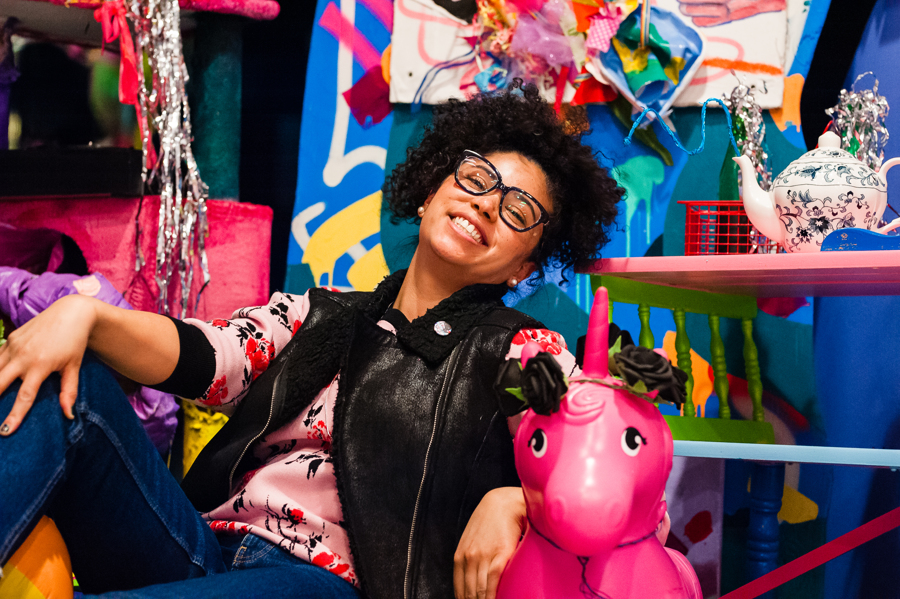Teens
March 11, 2021
Moe Gram on MCA Denver Teen workshop, the role of empathy in art, and women who have inspired her
In January of this year, eleven metro Denver high school students worked with Denver-based artist, educator, and community organizer Moe Gram to learn about 3D collage and create an exhibition for the Teen Idea Box at MCA Denver. The exhibition, titled Get Close But Don’t Touch, encourages viewers to explore the nuance of their own personal experience of the last year, while zooming out to acknowledge our collective societal experience at large.
We caught up with Moe and talked about her experience working with the teens on the exhibition, the role of empathy in art, and women who have inspired her.
Photos by Adrienne M. Kendall

Hey Moe! First of all, how are you doing?
Hi! I am doing great. Looking forward to spring and all the projects that come along with that.
What did the collaboration with the MCA Denver teens look like for Get Close But Don’t Touch? How did everyone’s respective experiences with living through—and continuing to live through— the pandemic, social unrest, and all that has happened in the last year materialize in the installation?
The collaboration started with conversations between myself and the teens about what it meant to “get close, but don’t touch.” Naturally the pandemic came into play. Other topics that were brought up were the idea of connecting with our celestial being, wanting relationships, revisiting memories, and thoughts about technology, the ways we use technology, etc. We continued discussing our points of view. We talked about materials that support our conversations and also began creating our own individual work on wood panels. Each teen was also given a $25 Visa gift card, and each card allowed teens to purchase any materials they wanted for their project from thrift stores. When we came into the museum, teens were asked to install their wood panels and to make those panels connect with the rest of the work. In the last hour of their time, they were asked to step away from their own art and work on the greater piece at large. Each individual had a very specific conversation in mind and what the viewers see is a mix of personal ideas and the collective view at the same time.

What did you glean from working with the teens?
Working with the teens was truly a beautiful process. Some of the biggest takeaways was the ability to examine my creative process from an educational lens. I was able to think about how my work applies to their own creative practices and then give them tools to expand their work. It is also very refreshing to work with younger minds. Their considerations and experiences are very different from my own so it was great to have that exposure to their perspectives.

As a community organizer, artist, and educator, how have these three roles intersect, morphed, and changed within the current landscape?
Well community organizing just hasn’t really existed in my work for about a year now. That is something that has been very odd to me. The experience with the teens gave me a taste of that part of my life. As an educator I have been working remotely and teaching my visual arts classes from home. Doing that has allowed me to show my students the work I do on a more intimate level. I teach from my studio so they have seen a wide variety of works move in and out of my space. I did a creative process lesson from Crush Walls, I taught composition from MCA Denver as I was installing the teen project. Remote learning has been a bittersweet blessing in that way.
Your work involves themes of empathy and connection. What is the role of empathy in these deeply trying times? How can art encourage empathy in ways that language or other mediums might not be able to?
The state of the United States specifically is very divided at the moment. We are seeing humans expressing their empathy but not truly allowing that empathy to extend past people who look like them or who come from similar backgrounds. The beauty of art lies in its ability to expand minds and challenge perspectives. My art is very maximalist with bright colors, so it is approachable to people. That allows a very specific invitation for the viewers to explore the work. As people explore the work they are confronted with a conversation and they have to dive deeper. The work demands it. What is also lovely about the deep dive, is that often the conversation starts as an internal dialogue. Individuals have space to interpret and unpack their views internally before discussing with others. And because they bore witness to the work, that conversation will not leave them. Sometimes words, social media and other experiences can be very fleeting. When done right, art can deeply implant its ideas in our minds.
March is Women’s History Month. What women—artists, family, friends, activists, culture changers, thought leaders, etc.—have inspired you in your personal life and in your work?
This is a difficult question because the network of women who either supported, inspired, or encouraged me thus far is vast. No person reading this interview has the attention span necessary for such a list. So I’ll be specifically broad. Black women like my mother and grandmother, who spend most of their lives working to uphold families and support children on their own I hold close to my heart. The strength of Black women despite society's care is forever empowering to me. Women to take up space unapologetically in favor of the nourishment of our communities inspire me. Young women who have hope and ambition reignite my own fire for success. Women who are able to lead while simultaneously expressing vulnerability renew my strength. Women who are tough in spaces where they do not always feel safe and are frequently alone in a room full of men give me a great sense of pride. I can go on, but I think the true sentiment is that it isn’t just a few women who inspire me, but the collective of our abilities that truly lights up my soul.

As a female artist yourself, what’s one of the messages you want to spread to women, whether they’re artists or not?
Exist and do not diminish who you are on behalf of someone else's comfort. You are here, so be here fully. Do not allow any person to make you feel as though you are not worthy of acknowledgement. Be exactly who you are, because that is exceptional.